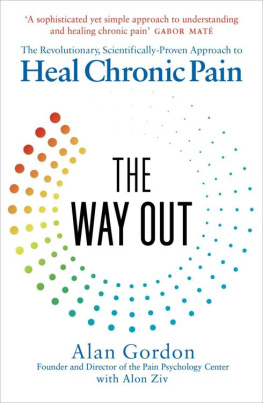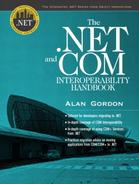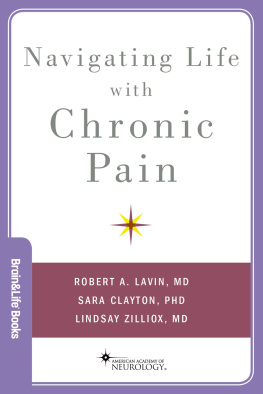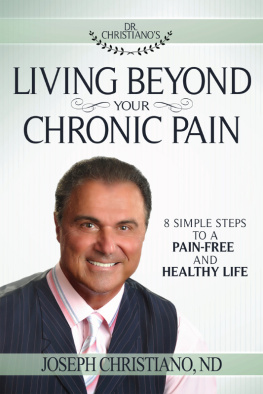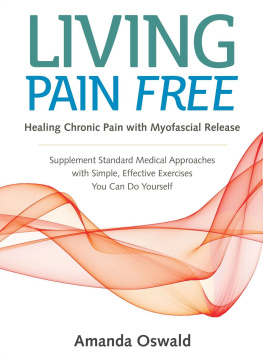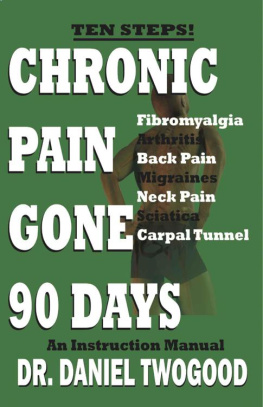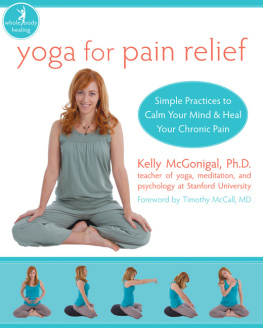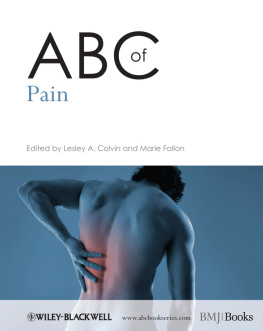Alan Gordon with Alon Ziv
WAY OUT
The Revolutionary Scientifically Proven Approach to
Heal Chronic Pain

Contents
About the Authors
Alan Gordon is the founder and director of the Pain Psychology Center in California, a leading treatment facility for chronic pain sufferers that sees over 1,500 patients from around the world every year. Debilitated by chronic pain throughout his body for several years and frustrated by the lack of effective treatment, Gordon developed the ground-breaking Pain Reprocessing Therapy (PRT) a highly effective system of psychological techniques that rewire the brains neural circuits to turn off stuck pain signals. He is an adjunct assistant professor at the University of Southern California.
Alon Ziv has a degree in neuroscience and was awarded the Certificate of Distinction in Teaching in Biology from UCLA.
Advance Praise for The Way Out
The Way Out offers a wonderfully clear and compelling combination of personal experience and the latest breakthroughs in brain science to show how to reduce chronic pain. Beautifully written, with gentle humor and genuine compassion, the authors start from acknowledging the reality of chronic pain and invite you to try techniques that promise a new freedom that might have seemed impossiblea transformation that will affect both you and those with whom you share your life.
M ARK W ILLIAMS , P ROFESSOR E MERITUS OF CLINICAL PSYCHOLOGY , U NIVERSITY OF O XFORD, AND COAUTHOR OF M INDFULNESS
If you suffer from chronic pain (or know someone who does), The Way Out is an optimistic, science-based book about managing the mind-body connection to healing. Alan Gordon writes with compassion, empathy, and a deep understanding of living with pain. Finding relief from his own suffering prompted him to find freedom for others.
S HARON S ALZBERG, AUTHOR OF L OVINGKINDNESS AND R EAL C HANGE
The Way Out highlights the role of neuroplasticity in chronic pain and explores how to tackle it. This is a great positive step forward in chronic pain treatment.
C LIFFORD W OOLF , MD, PROFESSOR OF NEUROLOGY AND NEUROBIOLOGY , H ARVARD M EDICAL S CHOOL
The strain in pain lies mainly in the brain. This accessible, warm book is a reminder of how you can learn to better control pain by learning to think differently about it.
D AVID S PIEGEL , MD, W ILLSON P ROFESSOR AND A SSOCIATE C HAIR OF P SYCHIATRY & B EHAVIORAL S CIENCES , D IRECTOR OF THE C ENTER FOR I NTEGRATIVE M EDICINE , S TANFORD U NIVERSITY S CHOOL OF M EDICINE, AND COAUTHOR OF T RANCE AND T REATMENT
Its long been assumed that chronic pain is irreversible, but The Way Out introduces an approach that proves otherwise. I have seen the power of this treatment firsthand. Patients who suffered for years or even decades have made remarkable recoveries. The Way Out is, quite simply, the most effective treatment for chronic pain.
H OWARD S CHUBINER , MD, CLINICAL PROFESSOR , M ICHIGAN S TATE U NIVERSITY C OLLEGE OF H UMAN M EDICINE, AND FOUNDER AND DIRECTOR OF THE M IND -B ODY M EDICINE P ROGRAM , A SCENSION P ROVIDENCE H OSPITAL
To Christie,
For your friendship, collaboration, and the countless pictures of your dog sleeping in a shoe.
A.G.
To Krystal,
As long as were together, life will always be good.
A.Z.
Foreword
I didnt start out as a believer. Like many people, I was uncertain about how deeply mind-body interventions can affect the course of chronic pain, and for whom. I am inherently skeptical. But I also really want to know the answers, so my instinct is to gather scientific evidence. I have spent a good part of my career studying whether changing your mind can affect your brain and body. If it can, which kinds of changes are possible, and which are not? What conditions are required to make these changes? If your thoughts do affect your body, are they large enough to be meaningful, and profound enough to last?
When I first met Alan Gordon, my overwhelming experience of him was that he is a believer. As a former chronic pain sufferer who has now recovered, he believes that it is possible to go from suffering from debilitating pain to being pain-free, without drugs or surgery. He demonstrates that belief in action with an infectious enthusiasm and a commitment to helping each individual he works with. Over the past two years, Ive experienced a transformation in my belief as well. Ive come to believe that the right ideas about chronic pain, put into practice through mind-body treatment, can have dramatic benefits for many or even most peopleeven after real injuries that give rise to real pain.
I got involved with Alan via serendipity. I had met Alans colleague, Dr. Howard Schubiner, several times at scientific meetings. Im a neuroscientist studying pain circuitry with functional magnetic resonance imaging (fMRI). I remember Howard telling me, We have this treatment that really works. Weve been helping people recover from chronic pain for yearsyou should study that! It didnt click. Im fascinated by mind-body interventions, but we were studying basic brain circuits, with no funding or infrastructure to study patients.
My graduate student Yoni Ashar and I had been brainstorming topics for his Ph.D. dissertation. Yoni suffered from chronic back pain for several years, which made back pain a personally meaningful topic of study. This is where the serendipity begins. Howard got in touch again, with fMRI imaging results from a patient who showed dramatic improvement after Alans treatment. The results were tantalizing. They showed changes in the medial prefrontal cortex and the anterior insula. These areas of the brain are connected, and part of a network that assigns personal meaning to input that comes from the body. These areas have also been among the most frequently identified in studies of chronic pain. It seems as if part of the problem for many people with chronic pain is the significance the brain attaches to pain and things that might cause it. We decided to go for it and start a study on Alans treatment in people with chronic back pain.
We started with modest goals. At first, we planned to scan just a few people undergoing treatment. Then Yoni attended Alan and Howards weekend training course and saw the power of the treatment in action. Meanwhile, Alan started a crowdfunding campaign that generated both money for the study and, even more important, excitement from people who really wanted this to happen. I found some additional grant funding, and we expanded the study even further. We ended up conducting one of the largest fMRI studies of back pain to date. We did this with about a quarter of the funding that it would typically take, because everyoneYoni, Alan, Howard, and our terrific research assistants Laurie Polisky, Zach Anderson, and othersbelieved in the importance of this project and put their hearts and souls into getting it done.
The results of our study are what turned me into a believer. After being in chronic pain for, on average, eleven years, the majority of patients were pain-free or nearly so after a month of treatment. And so far, they appear to be staying that way. Let me be clear that there are still many questions to answer: For which kinds of pain, and which kinds of people, are such results possible? What are the active ingredients, and how much does improvement depend on who is delivering the treatment? How strongly does improvement depend on a patients openness to being cured? Chronic pain has multiple causes in the body and brain. We do not yet understand these, and we simply cannot measure pathology well enough in humans to determine the best treatment for every individual. But we did our best to make our study a rigorous, objective, unbiased test of how well Alans treatment worksand the data showed that people got better.

